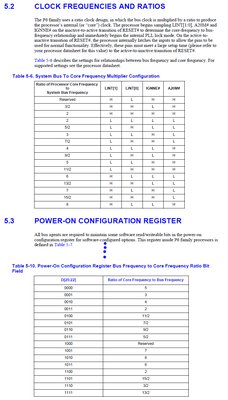First post, by feipoa
- Rank
- l33t++
Does anyone know the full extent of the Pentium Pro's multiplier options? I'm attaching a snippet from Intel's P6 Family of Processors, Hardware Developer’s Manual, September 1998
Does this mean the PPRO's multiplier can be set from 1.5x up to 8x? And does the second table imply that this can be done via software as well? The Intel VS440FX motherboard I'm using has jumper settings (documented and undocumented) for 2.0, 2.5, 3.0, and 3.5. I've heard of other boards having a 4x feature as well.
If it is adjustable in software, does anyone know of some software which can do this?
What's the fastest stable overclock of a Pentium Pro with and without voltage modification?
If software multiplier adjustment is not possible, has anyone modified a VS440FX motherboard for 4.0x or 4.5x operation?
Plan your life wisely, you'll be dead before you know it.
